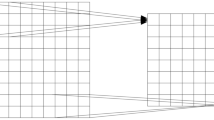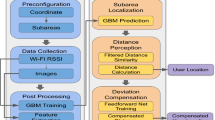Abstract
Indoor positioning techniques has become a key research issue for future smart services because of the high market value in providing location-based services via smartphones and ondemand services. In image sensor communications (ISC) case, one of the main advantages of the indoor navigation system is that the LED itself can transmit its location information using visible light communication. In addition, the camera usually has an angle of arrival sensor that facilitates the precise determination of not only user position but also user orientation. However, because of the nonlinear and highly complicated relationship between 3D scenery and a pictured 2D image, the development of a complex mathematical model is needed to estimate user position using a camera. Neural network is a good approach for minimizing this complicated relationship. Hence, it is possible to develop a precise positioning technique without any complicated mathematical model between the 3D world and 2D image coordinates. This paper proposes a neural network-based novel positioning technique. The proposed method exploits the projective invariant properties of a line that is virtually constructed with the help of ISC. Then, a neural network scheme is used to extract the camera orientation information from that virtual line. Next, a simple mathematical equation is used to estimate user position. Simulation results show the proposed method has better performance than the previous methods.









Similar content being viewed by others
References
Prigge, E., & How, J. (2000). An indoor absolute positioning system with no line of sight restrictions and building-wide coverage, Robotics and Automation, 2000. In Proceedings of ICRA, IEEE international conference on (Vol. 2, pp. 1015–1022).
Zhang, R., Bannoura, A., Hoflinger, F., Reindl, L. M., & Schindelhauer, C. (2013). Indoor localization using a smart phone. In Sensors Applications Symposium (SAS), IEEE, (pp. 38–42).
Rupp, T., Cord, T., Lohnert, R., & Lazic, D. E. (1998). Positioning and communication system for autonomous guided vehicles in indoor environment. In Electrotechnical Conference, 1998. MELECON 98, 9th Mediterranean, (Vol. 1, pp. 187–191).
Ayub, S., Heravi, B. M., Bahraminasab, A., & Honary, B. (2012). Pedestrian direction of movement determination using smartphone, Next Generation Mobile Applications. In Services and Technologies (NGMAST), 2012 6th International Conference on, (pp. 64–69).
Liu, G. H., Wang, W. B., Yuan, J. Y., Liu, X. Y., & Feng, Q. Y. (2009). A novel camera calibration method of variable focal length based on single-view, Electronic Commerce and Security, 2009. In ISECS ’09. Second International Symposium on, (Vol. 2, pp. 125–128).
Matsuda, J., Tan, J. K., Kim, H., & Ishikawa, S. (2007). Development of a fast 3-D object reconstruction technique, Control, Automation and Systems, 2007. ICCAS ’07. International Conference on, (pp. 2303–2306).
Saha, N., Ifthekhar, M. S., Le, N. T., & Jang, Y. M. (2015). Survey on optical camera communications: challenges and opportunities, in Optoelectronics, IET, (Vol. 9, no. 5, pp.172–183).
Hossen, M. S., Park, Y., & Kim, K.-D. (2015). Performance improvement fo indoor positioning using light-emitting diodes and an image sensor for light-emitteing diode communication. Optical Engineering, 54(4), 1–11.
Zhao, Q., Wang, F., & Sun, Z. (2006). Using neural network technique in vision-based robot curve tracking, intelligent robots and systems, 2006 IEEE/RSJ international conference on, (pp. 3817–3822).
Jun, J., & Kim, C. (1999). Robust camera calibration using neural network, TENCON 99. In Proceedings of the IEEE region 10 conference, (Vol. 1, pp. 694–697).
Kim, G., & Petriu, E. M. (2010). Fiducial marker indoor localization with artificial neural network. In Advanced intelligent mechatronics (AIM), 2010 IEEE/ASME international conference on, (pp. 961–966).
Ifthekhar, M. S., Mondal, R. K., Le, N. T., & Jang, Y. M. (2014). Simple method for indoor localization in OCC using smart phone image sensor. In Sixth international conference on ubiquitous and future networks (ICUFN), 2014, (pp. 55–58).
Ifthekhar, M. S., Hossain, M. A., Hong, C. H., & Jang, Y. M. (2015). Radiometric and geometric camera model for optical camera communications. In: Seventh international conference on ubiquitous and future networks (ICUFN), 2015, (pp. 53–57).
Haykin, S. (1999). Neural networks: A comprehensive foundation. Upper Saddle River: Prentice Hall, Inc.
Habib, A., Asmamaw, A., Kelley, D., & May, M. (2000). Linear features in photogrammetry. Geodtic science and surveying.
Bacakoglu, H., & Kamel, M. (1997). An optimized two-step camera calibration method, Robotics and Automation, 1997. In Proceedings of 1997 IEEE international conference on, (Vol. 2, pp. 1347–1352).
Acknowledgments
This work was supported by Institute for Information & communications Technology Promotion(IITP) grant funded by the Korea government(MSIP) (No. R0127-15-1025, Development of Optical Wireless Communications (OWC) Standardization).
Author information
Authors and Affiliations
Corresponding author
Rights and permissions
About this article
Cite this article
Ifthekhar, M.S., Le, N.T., Hossain, M.A. et al. Neural Network-Based Indoor Positioning Using Virtual Projective Invariants. Wireless Pers Commun 86, 1813–1828 (2016). https://doi.org/10.1007/s11277-016-3177-0
Published:
Issue Date:
DOI: https://doi.org/10.1007/s11277-016-3177-0




